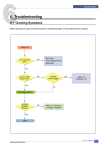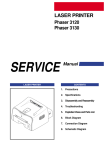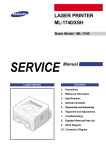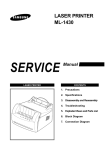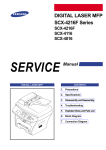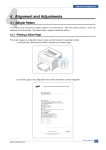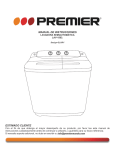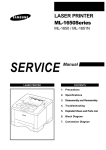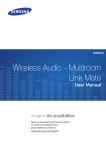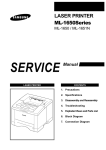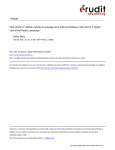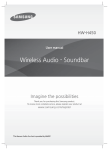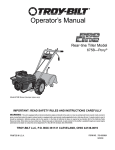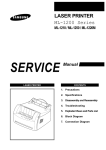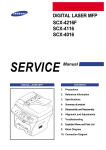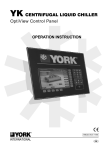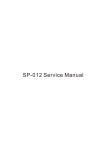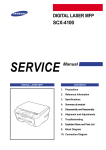Download Phaser 3130 Service Manual
Transcript
LASER PRINTER Phaser 3120 Phaser 3130 SERVICE LASER PRINTER Manual CONTENTS 1. Precautions 2. Specifications 3. Disassembly and Reassembly 4. Troubleshooting 5. Exploded Views and Parts List 6. Block Diagram 7. Connection Diagram 8. Schematic Diagram Precautions 1 1. Precautions The cautions in the below are items needed to keep in mind when maintaining and servicing. Please read carefully and keep the contents in mind to prevent accidents while servicing and to prevent that the machine gets damage. 1.1 Warning for safety. (1) Request the service by qualified service person. The service for this machine must be performed by a service person who took the additional education of this field. It is dangerous if unqualified service person or user tries to fix the machine. (2) Do not rebuild it discretionary. Do not attach or change pats discretionary. Do not dissemble, fix, and rebuilt it. If do, printer will abnormally work and electric shock or a fire can be occurred. (3) Laser Safety Statement The Printer is certified in the U.S. to conform to the requirements of DHHS 21 CFR, chapter 1 Subchapter J for Class 1(1) laser products, and elsewhere, is certified as a Class I laser product conforming to the requirements of IEC 825. Class I laser products are not considered to be hazardous. The laser system and printer are designed so there is never any human access to laser radiation above a Class I level during normal operation, user maintenance, or prescribed service condition. Warning >> Never operate or service the printer with the protective cover removed from Laser/Scanner assembly. The reflected beam, although invisible, can damage your eyes. When using this product, these basic safety precautions should always be followed to reduce risk of fire, electric shock, and injury to persons. CAUTION - INVISIBLE LASER RADIATION WHEN THIS COVER OPEN. DO NOT OPEN THIS COVER. VORSICHT - UNSICHTBARE LASERSTRAHLUNG, WENN ABDECKUNG GE FFNET. NICHT DEM STRAHL AUSSETZEN. ATTENTION - RAYONNEMENT LASER INVISIBLE EN CAS D OUVERTURE. EXPOSITION DANGEREUSE AU FAISCEAU. ATTENZIONE - RADIAZIONE LASER INVISIBILE IN CASO DI APERTURA. EVITARE L ESPOSIZIONE AL FASCIO. PRECAUCION - RADIACION LASER IVISIBLE CUANDO SE ABRE. EVITAR EXPONERSE AL RAYO. ADVARSEL. - USYNLIG LASERSTR LNING VED BNING, N R SIKKERHEDSBRYDERE ER UDE AF FUNKTION. UNDG UDSAETTELSE FOR STR LNING. ADVARSEL. - USYNLIG LASERSTR LNING N R DEKSEL PNES. STIRR IKKE INN I STR LEN. UNNG EKSPONERING FOR STR LEN. VARNING - OSYNLIG LASERSTR LNING N R DENNA DEL R PPNAD OCH SP RREN R URKOPPLAD. BETRAKTA EJ STR LEN. STR LEN R FARLIG. VARO! - AVATTAESSA JA SUOJALUKITUS OHITETTAESSA OLET ALTTIINA N KYM TT M LLE LASERS TEILYLLE L KATSO S TEESEEN. Service Manual 1-1 Precautions 1.2 Caution for safety 1.2.1 Precaution related noxious material The toner in a printer cartridge contains a chemical material, which might harm human body if it is swallowed. Please keep children out of the toner cartridge. 1.2.2 Precaution related electric shock or fire It is possible to get electric shock or burn by fire if you don't fallow the instructions of the manual. (1) Use exact voltage. Please do use an exact voltage and wall socket. If not, a fire or an electric leakage can be caused. (2) Use authorized power code. Do use the power code supplied with PRINTER. A fire can be occurred when over current flows in the power code. (3) Do not insert many codes in an outlet. If do, a fire can be occurred due to flow over current in an outlet. (4) Do not put water or extraneous matter in the PRINTER. Please do not put water, other liquid, pin, clip, etc. It can cause a fire, electric shock, or malfunction. If it is happened, turn off the power and remove the power plug from outlet immediately. (5) Do not touch the power plug with wet hand. When servicing, do remove the power plug from outlet. And do not insert or take off it with wet hand. Electric shock can be occurred. (6) Caution when inserting or taking off the power plug. The power plug has to be inserted completely. If not, a fire can be caused due to poor contact. When taking off the power plug, do grip the plug and take it off. If grip the line and pull over, it could be damaged. A fire or electric shock could cause. (7) Management of power code. Do not bend, twist, or bind it and place other materials on it. Also, do not fix it with staples. If the power code gets damage, a fire or electric shock can be caused. A damaged power code must be replaced immediately. Do not repair the damaged part and reuse it. A repaired part with plastic tape can be occurred a fire or electric shock. Do not spread chemicals on the power code. Do not spread insecticide on the power code. A fire or electric shock can be occurred due to thinner(weak) cover of the power code. (8) Check whether the power outlet and the power plug are damaged, pressed, chopped, or blazing fire or not. When such inferiorities are found, repair it immediately. Do not make it pressed or chopped when moving the machine. (9) Caution when thundering, and being flash of lightening. It causes a fire or electric shock. Take the power plug off when thundering. Do not touch cable and device when thundering and being flash of lightening. (10) Do avoid the place where is moisture or has dust. Do not install the printer in where have lots of dust or around humidifier. A fire can be occurred. A plug part need to clean well with dried fabric to remove dust. If water drops are dripped on the place covered with dust, a fire can be occurred. (11) Avoid direct sunlight. Do not install the printer near to window where directly contacts to the sunlight. If the machine contacts sunlight long time, the machine cannot work properly because inner temperature of the machine is getting higher. A fire can be caused. (12) Turn off the power and take off the plug when a smoke, strange smell, or sound from the machine. If you keep using it, a fire can be occurred. (13) Do not insert steel or metal piece inside/outside of the machine. Do not put steel or metal piece into a ventilator. An electric shock could be happened. 1-2 Service Manual Precautions 1.2.3 Precaution related handling the machine. If you ignore this information, you could get harm and machine could be damaged. (1) Do not install it on the different levels, or slanted floor. Please confirm whether it is balanced or not after installation. If it is unbalanced, an accident can be happened due to the machine fell over. (2) Be careful not to insert a finger or hair in the rotating unit. Be careful not to insert a finger of hair in the rotating unit (motor, fan, paper feeding part, etc) while the machine is operating. Once it happens, you could harm. (3) Do not place a pot contains water/chemical or small metals. If those are got into the inner side of machine, a fire or electric shock can be occurred. (4) Do not install it in where lots of moisture or dust exists or where raindrop reaches. A fire or electric shock can be caused. (5) Do not place a candlelight, burning cigarette, and etc. on the machine. Do not install it near to heater. A fire can be occurred. 1.2.4 Precaution when assembly/disassembly When replace parts, do it very carefully. Do memorize the location of each cable before replace parts for reconnecting it afterwards. Do memorize. Please perform the below before replace or disassembly the parts. (1) Check the contents stored in the memory. All the information will be erased after replace main board. The information needed to keep has to be written down. (2) Before servicing or replacing electric parts, take off a plug. (3) Take off printer cables and power code connected to printer. (4) Do use formal parts and same standardized goods when replacing parts.Must check the product name, part code, rated voltage, rated current, operating temperature, etc. (5) Do not give an over-force when release or tighten up the plastic parts. (6) Be careful not to drop the small parts such as screws in the printer. (7) Be careful not to change the location of small parts such as screws when assembling and disassembling. (8) Do remove dust or foreign matters completely to prevent fire of tracking, short, or etc. (9) After finished repair, check the assembling state whether it is same as before the repair or not. Service Manual 1-3 Precautions 1.3 ESD Precautions Certain semiconductor devices can be easily damaged by static electricity. Such components are commonly called “Electrostatically Sensitive (ES) Devices”, or ESDs. Examples of typical ESDs are: integrated circuits, some field effect transistors, and semiconductor “chip” components. The techniques outlined below should be followed to help reduce the incidence of component damage caused by static electricity. Caution >>Be sure no power is applied to the chassis or circuit, and observe all other safety precautions. 1. Immediately before handling a semiconductor component or semiconductor-equipped assembly, drain off any electrostatic charge on your body by touching a known earth ground. Alternatively, employ a commercially available wrist strap device, which should be removed for your personal safety reasons prior to applying power to the unit under test. 2. After removing an electrical assembly equipped with ESDs, place the assembly on a conductive surface, such as aluminum or copper foil, or conductive foam, to prevent electrostatic charge buildup in the vicinity of the assembly. 3. Use only a grounded tip soldering iron to solder or desolder ESDs. 4. Use only an “anti-static” solder removal device. Some solder removal devices not classified as “anti-static” can generate electrical charges sufficient to damage ESDs. 5. Do not use Freon-propelled chemicals. When sprayed, these can generate electrical charges sufficient to damage ESDs. 6. Do not remove a replacement ESD from its protective packaging until immediately before installing it. Most replacement ESDs are packaged with all leads shorted together by conductive foam, aluminum foil, or a comparable conductive material. 7. Immediately before removing the protective shorting material from the leads of a replacement ESD, touch the protective material to the chassis or circuit assembly into which the device will be installed. 8. Maintain continuous electrical contact between the ESD and the assembly into which it will be installed, until completely plugged or soldered into the circuit. 9. Minimize bodily motions when handling unpackaged replacement ESDs. Normal motions, such as the brushing together of clothing fabric and lifting one’s foot from a carpeted floor, can generate static electricity sufficient to damage an ESD. 1-4 Service Manual Precautions 1.4 Tool for Troubleshooting The following tools are recommended for safe and smooth troubleshooting described in this service manual. 1 DCU(Diagnostic Control Unit) Standard : Test equipment to diagnose the Laser printer supplied by Samsung Electronics. 4 Driver Standard : "-" type, "+" type (M3 long, M3 short, M2 long, M2 short). 5 Pinset Standard : For general home use, small type. 2 DVM(Digital Volt Meter) Standard : Indicates more than 3 digits. 6 Cotton Swab Standard : For general home use, for medical ser-vice 7 Cleaning Equipments a IPA(Isopropyl Alcohol)dry cloth or a soft stuff neutral detergent 3 Electronic Scale 8 Software(Driver) installation CD ROM Standard : Equipment to check the weight of consumables(toner cartridge) supplied by Samsung Electronics. (The gram unit can be measured.) Mind your hands not to be touched when you disassemble and reassemble PBA ASS'Y, such as the main board, SMPS, HVPS. Service Manual 1-5 Specifications 2 2. Specifications 2.1 General Specifications ITEM DESCRIPTION Print Technology Non-impact Electro-photograpic Printing Developing system Non-Magnetic, Mono-Component Developing System Print Speed(1) 16 PPM : A4 size , 5% Character pattern 17 PPM : Letter size , 5% Character pattern Resolution Phaser 3120 : True 600 X 600 DPI Phaser 3130 : 1200 X 600 DPI Source of Light Laser diode (LSU : Laser Scanner Unit) Warm-Up Time Power-on boot : 30 seconds or less First Print Out Time Less than 11 seconds (Ready to 1st page out) Media Size 75 X 125 (3” X 5”) mm to 216 X 356 (8.5” X 14”)mm Media Thickness 16 ~ 24 lb Dimension(W X D X H) 348 X 355 X 193mm / 13.7 X 14 X 7.6 inch Weight Net : 7 Kg /15.4 lb Gross : 9.5 Kg (Max.) Acoustic Noise (1) Stand by : Less than 35 dB Printing: Less than 50 dB Machine Life 120,000 Sheets Periodic Replacing Parts(2) Pick Up Roller : 60,000 Sheets Feed Roller : 60,000 Sheets Transfer Roller: 60,000 Sheets Fuser Assembly : 60,000 Sheets (1) (2) For measuring the printing speed, count the papers which outputted within one minute from when the second page starts to be printed. (A4, 5% character pattern standard) The life span of the consumption parts can be checked by printing the demo page or the system list. (Refer to the 6.3 Receive the service information) Service Manual 2-1 Specifications 2.2 Controller Specification DESCRIPTION ITEM Phaser 3120 Processor(CPU) Phaser 3130 Samsung Jupiter4 90MHz OS Compatibility (1) Samsung SPGPm 166MHz Win 98x/NT4.0/ME/2000/XP, Various Linux OS,Mac(Mac OS 8.6 ↑) Memory FLASH ROM(PROGRAM) : 0.5MB flash RAM : 8 MB RAM : 32 MB EEPROM(NVRAM) : 512byte Emulation SPL(Samsung Printer Language) PCL6, IBMProPrinter, EPSON Interface USB 1.1 USB - USB 2.0 - 12 Mbps 1 port Parallel : IEEE 1284 - Modes supported : Compatible,Nibble,Byte,ECP External Network Adaptor(Optional) Interface switching Automatic Interface time-out 5min(Max.) Font Windows Font 45 Scalable, 1 Bitmap (1) The SPL series model is USB exclusive use, so it supports the environment beyond the WIN 98. 2.3 Electrical Specification ITEM Input Voltage Power Consumption DESCRIPTION Nominal input voltage 200-240 VAC / 100~127VAC Input voltage range 189-264 VAC/ 90~132VAC Nominal frequency 50/60 Hz Frequency tolerance +3Hz Printing : 280W Avg or less Power Save : 10W Avg or less 2.4 Environmental Range ITEM 2-2 OPERATING STORAGE Temperature 10~32 C(50-90 oF) -20~40 C (-4~104 oF) Humidity 20~80%RH 10~80%RH Service Manual o o Specifications 2.5 TONER Cartridge (Developer) ITEM DESCRIPTION REMARK Life span 3,000 sheets IDC 5% pattern Developing Non-magnetic Mono Conponent Contact Developing Charging Conductive Roller Charging Toner checking sensor Not Available Ozone 0.1PPM or less Style Single cartridge 8 hours 2-Paper Handling Specifications Please refer to "Paper Specifications" on user guide • Input Paper Size PAPER DIMENSIONS WEIGHT A4 210 X 297 mm Letter 216 X 279(8.5 X 11") Legal(Legal14") 216 X 356(8.5 X14") JIS B5 182 X257mm (7.2 X 10") Folio(Legal13") 216 X 330mm (8.5 X 13") Minimum size (Custom) 76 X 127mm (3 X 5") Maximum size (Custom) 216 X 356mm (8.5 X 14") Transparency(OHP) Same minimum and maximum Thickness: Label paper sizes as listed above 0.10 X 0.14 mm (0.0039 X 0.0055") Envelopes 60 to 90 g/m2 bond(16 to 24 lb) 60 to 163 g/m2 bond(16 to 43 lb) Up to 90 g/m2 bond(16 to 24 lb) • Input capacity Cassette: 250 sheets Manual : 1 sheet • Output capacity Face Down : 50 sheets(20lb) Face Up : 1 sheet(OHP, Lavbel, Cut Sheet, Envelope) Service Manual 2-3 Specifications 2-4 Service Manual Disassembly and Reassembly 3 3. Disassembly and Reassembly 3.1 General Precautions on Disassembly When you disassemble and reassemble components, you must use extreme caution. The close proximity of cables to moving parts makes proper routing a must. If components are removed, any cables disturbed by the procedure must be restored as close as possible to their original positions. Before removing any component from the machine, note the cable routing that will be affected. Releasing Plastic Latches Many of the parts are held in place with plastic latches. The latches break easily; release them carefully. To remove such parts, press the hook end of the latch away from the part to which it is latched. Whenever servicing the machine, you must perform as follows: 1. Check to verify that documents are not stored in memory. 2. Be sure to remove the toner cartridge before you disassemble parts. 3. Unplug the power cord. 4. Use a flat and clean surface. 5. Replace only with authorized components. 6. Do not force plastic-material components. 7. Make sure all components are in their proper position. Service Manual 3-1 Disassembly and Reassembly 3.2 Top Cover 1. Pull the Cassette out of the printer. 4. Unlatch the front ends of the Top Cover. Cassette 2. Remove the Front Cover in the direction of arrow. 5. Remove the Top Cover in the direction of arrow. Top Cover Front Cover 3. Remove four screws. 6. Remove the Rear Cover from the Top Cover. Rear Cover 3-2 Service Manual Disassembly and Reassembly 3.3 Fuser 1. Before you remove the Fuser, you should remove: - Top Cover(see page 3-2) 5. Remove one screw and take the Idle Gear out. Idle Gear 2. Unplug two connectors(Block) from the boards, then remove four screws. Fuser Ass'y 6. Remove four screws and divide the Fuser into two parts Fuser Cover 3. Remove two screws and take the Thermostat out of the Fuser. Thermostat 4. Remove two screws and take the Halogen Lamp out of the Heat Roller. 7. Remove the Thermister from the Fuser Cover. Heat Roller Thermister Halogen Lamp Service Manual 3-3 Disassembly and Reassembly 3.4 Exit Roller 1. Before you remove the Fuser, you should remove: - Top Cover(see page 3-2) Exit Gear Bearing Exit Roller 2.Remove the Exit Gear, Bearing and Exit Roller. 1 2 3.5 LSU 1. Before you remove the Fuser, you should remove: - Top Cover(see page 3-2) 4. Unplug two connector from the LSU 2. Remove two screws and unplug one connector from the Frame. 5. Unplug four screws and take the LSU out. LSU 3. Remove the LED PBA Ass’y as shown below. LED PBA Cover 3-4 Service Manual Disassembly and Reassembly 3.6 Fan 1. Before you remove the Fuser, you should remove: - Top Cover(see page 3-2) 2. Unplug the connector from the SMPS and remove the one screw. Then take out the Fan. DC Fan 3.7 Driver Ass’y 1. Before you remove the Fuser, you should remove: - Top Cover(see page 3-2) 3. Unplug one connector from the Driver Ass’y Drive Ass'y 2. Remove the six screws from the Drive Ass’y. Service Manual 3-5 Disassembly and Reassembly 3.8 Engine Shield Ass’y 1. Before you remove the Fuser, you should remove: - Top Cover(see page 3-2) - Fuser Connector(see page 3-3) 2. Remove the fourteen screws securing from the Engine Shield Ass’y and unplug the all connectors. Then take the Engine Shield Ass’y. Engine Shield Ass'y 3.9 Main PBA 1. Before you remove the Fuser, you should remove: - Top Cover(see page 3-2) - Engine Shield Ass’y(see page 3-6) 2. Unplug one connector and remove five screws from the Main PBA. Then lift the Main PBA out, as shown below. 3-6 Service Manual Main PBA Disassembly and Reassembly 3.10 SMPS 1. Before you remove the Fuser, you should remove: - Top Cover(see page 3-2) - Engine Shield Ass’y(see page 3-6) 3. Remove one screw and unplug one connector from the Main PBA. 2. Unplug one connector and remove three screws then take the Inlet Ass’y out. Inlet Bracket 4. Remove three screws and take The SMPS out. SMPS Service Manual 3-7 Disassembly and Reassembly 3.11 Transfer Roller 1. Before you remove the Fuser, you should remove: - Top Cover(see page 3-2) - LSU(see page 3-4) 3. Unplug the PTL Holder Connector, then remove the PTL Holder and PTL Lens, as shown below. PTL Holder PTL Lens 2. Remove three screws and take the Transfer Earth out. Transfer Earth 4. Unlatch the Bush and remove it. Then lift the Transfer Roller out, as shown below. Transfer Roller Bush 3-8 Service Manual Disassembly and Reassembly 3.12 Feed Roller 1. Before you remove the Fuser, you should remove: - Top Cover(see page 5-2) - Drive Ass’y(see page 5-7) 5. Remove the Idle Gear and Feed Gear2. Feed Gear2 2. Remove two screws from the Guide Paper and take it out. Guide paper Idle Gear 6. Remove the Feed Gear 1 Ass’y, as shown below. 3. Pull up the Feed Idle Bush and Feed Idle Shaft, as shown below. Feed Gear1 Ass'y Feed Idle Shaft Bush 7. Remove the Feed Roller and Feed Roller 1, as shown below. 4. Remove three screws from the Feed Bracket and take it out. Feed Roller Feed Bracket Feed Roller1 Service Manual 5-11 Disassembly and Reassembly 3.13 Pick Up Roller 1. Before you remove the Fuser, you should remove: - Top Cover(see page 3-2) - Drive Ass’y(see page 3-5) - Engine Shield Ass’y(see page 3-6) 3. Remove the Pick up Ass’y, as shown below. 2. Remove the Pick up Gear Ass’y, as shown below. Pick up Gear Ass'y Bush 1 2 Pick up Ass'y 3.14 Solenoid 1. Before you remove the Fuser, you should remove: - Top Cover(see page 3-2) - Drive Ass’y(see page 3-5) - Engine Shield Ass’y(see page 3-6) - Pick Up Roller(see page 3-10) 2. Remove two screw then remove The Manual Solenoid and Pick Up Solenoid. (Pick up) Solenoid (Manual) Solenoid 3-10 Service Manual TROUBLESHOOTING 4 4. Troubleshooting 4.1 How to use DCU 4.1.1 DCU Setup You can examine the malfunction of the printer. To perform DCU, open the front discharge cover and leave the connect the harness wire(10 pin/4 pin) to the CN10(4 pin) of the Main control board. ML SERIES DIAGNOSTIC CONTROL UNIT 04 DEV 300 DEV 350 DEV 350 05 LSU READY LSU MT & LD LSU MOTOR 07 PAPER EMPTY PAPER WIDTH NEW CRU 08 EXIT SENSOR FEED SENSOR SELF TEST 09 COVER OPEN STATUS 10 COER HEATING PRINTING TEMP READY HEAT DIAGNOSTIC OFF ON DIAGNOSTIC CODE 00 01 02 03 04 05 06 07 08 09 10 11 MAIN MOTOR OPERATING SYSTEM MAIN HIGH-VOLTAGE ON TRNSFER HIGH-VOLTAGE (-)ON THV(+) REFERANCE VOLTAGE DEV/SUPPLY HIGH-VOLTAGE ON/PTL ON LSU OPERATING SYSTEM PICKUP CLUTCH ON PEEMPTY/PWITH/NEW CRU TEST FEED & EXIT SENSOR TEST COVER OPEN SENSOR TEST FUSER TEST HOT BURN TEST 12 CLEAN MODE PRINT 13 THV(+)TRIGGER, ALL HV & FAN ON 14 THV(+) REFERENCE ON STATUS CODE 61 WARM UP 00 01 02 03 04 READY READY READY READY READY 20 30 40 50 PRINT START FEED SENSOR ON FEED SENSOR OFF PAPER OUT 69 SLEEP MODE (REGAL) (LETTER) (A4) (EXECUTIVE) (B5) ERROR STATUS CODE 60 62 68 64 70 71 72 73 95 DIAGNOSTIC MODE DOWN UP OPEN FUSER ERROR LOW TEMPERATURE ERROR OVER HEATING ERROR COVER OPEN ERROR NO PAPERR PAPER JAM 0 PAPER JAM 1 PAPER JAM 2 LSU NOT READY SHIFT STOP ENTER TO ENTER DIAGNOSTIC MODE, PUSH THREE BUTTONS SIMUL ANEOUSL AND TURN THE PRINTER POWER ON. Service Manual 4-1 TROUBLESHOOTING 4.1.2 Code Connect DCU to the printer and turn the power on. It show 7 Segment FND on the panel and each code tells the function of the printer. 1) Normal Code While printing or warming up, it indicate the position of the paper Code State 61 00~05 Warm up Ready(kind of paper) 20, 21, 22 Print Start 30 40 50 69 Feed Sensor On Feed Sensor off Paper Out Sleep Mode Description The printer is on, the cover is open or close. The printer is ready, the paper is detected when the first paper is printed. 00: Legal ,01: Letter ,02: A4 ,03: EXEC ,04: B5 ,05: Folio, 06: A5/A6 The engine controller received the print order from the video controller. 20: 1st, 21: MP, 22: SCF The paper is passing out of the Feed Sensor. The paper has passed out of the Feed Sensor. The paper has passed out of Exit Sensor. The fuser power turned off to minimize the power consumption. 2) Error Code When detecting the malfunction, the printing is stopped to indicate error code. Code State 60, 62, 68 Fuser Error 64 65 70 71 72 Cover Open CRU Error No Paper Paper Jam 0 Paper Jam 1 73 Paper Jam 2 76 95 Out Bin Full LSU Not Ready 4-2 Service Manual Description The error in the fuser occurred. There is a short circuit in the thermistor and the thermostat while printing, Low Temperature Error occurs. • 60: Open Fuser Error • 62: Low Heat Error • 68: Over Heat Error The Printer Cover is open. The Toner Cartridge not installed, No paper in the paper cassette. The front part of paper is jammed between pickup unit and Feed sensor. The front part of paper is jammed between the Discharge sensor and Feed sensor. The front part of paper is jammed just after passing through the discharge sensor. The Out bin is filled with paper. LSU Scanner Motor not ready or Hsync signal not output. TROUBLESHOOTING 4.1.3 Self Diagnostic Mode If Error code occurs due to malfunction of the printer, perform Self Diagnostic Mode to solve the problem. The printer works only in the self-test mode to solve the malfunction problem. To enter the self-test mode, turn the power on pressing the buttons of [Down], [Shift] and [Stop] at the same time. Release the button within 2 or 3 seconds if 78 shows in the DCU. If 00 shows in the DCU, press the button [Up] or [Shift] to select the self+test , and press the button of [Enter] to operate. To stop, press the button of [shift] and [Enter] together. Code Description 00 Main Motor Operating System Only the main motor is in operation. 01 Main High Voltage On(THV-) -1400 voltage output by MHV terminal. Caution : High voltage probe should be used. 02 Transfer High Voltage(-)On(THV-) -1000 voltage output by MHV terminal. Caution : High voltage probe should be used. 03 Transfer High Voltage (+)Reference on (THV +) +800 voltage output by MHV terminal. Caution : High voltage probe should be used. 04 DEV/supply High Voltage : DEV/Supply High Voltage Test. The left one of the three LEDs in the self-test panel is on when DEV high voltage Supply high voltage output by each HV terminal(-500V). Press the [Up] button to switch the voltage. The middle and right one of the three LEDs are on and -650 voltage output by DEV HV terminal. Caution : High voltage probe should be used. 05 LSU Operating System The scanning motor of LSU is in operation, the right LED of the three buttons on. Press the [Up] button to Check LD. LD is functioning and the middle button is on. If the LD is normal, all LEDs are on. 06 Pickup clutch on The Solenoid in the printer is in operation. To stop the operation, Press the button [shift] and [Enter] together. Service Manual 4-3 TROUBLESHOOTING Code 4-4 Description 07 Paper Empty Sensor Test : If activate the Actuator of the PEMPTY Sensor, the left and right of the three LEDs are on. Paper Empty Sensor ON/OFF 1st LED ON/OFF 08 Feed & Exit Sensor Test Test the Feed sensor and Discharge sensor in the same way as '07'. Feed Sensor ON/OFF 2nd LED ON/OFF Exit Sensor ON/OFF 3rd LED ON/OFF 09 Cover Open Sensor Test Test the Cover Open Sensor in th same way as code '07’ Cover Open Sensor ON/OFF 1st LED ON/OFF 10 Fuser Test If the [Enter] button pressed, the right LED is on and temperature of the fuser is up to READY Mode. If the [Up] button pressed, the middle LED is on and temperature of the fuser is up to Printing Mode. If you press the button once more, the left LED is on and temperature of the fuser is up to overheat Mode. 11 Hot Burn Test If the [enter] button pressed, the printer is continuously printing without detection. Turn the power off to stop operation. 12 Cleaning Mode Print Mode Print the paper to clean the OPC Drum in the Cartridge. 13 THV(+) TRIGGER. ALL HV : All high voltage output by each HV terminal and LSU and the fan is in operation. In this mode, electronic resistance of transfer roller and high voltage is detected. 14 PTL Test : Indicates the function of the PTL, same method of the code ‘07’. 15 Fan Test : Indicates the function of the Fan, same method of the code ‘07’. 16 Manual Pickup Test : Indicates the function of th Manual Pickup, same method of the code ‘07’. 17 Manual Sensor Test : Indicates the function of the Manual Sensor, same method of the code ‘07’. Service Manual TROUBLESHOOTING No. Function Enter 00 Motor Motor Run Motor Stop 01 MHV Mhv On Mhv Off 02 THV(-) Thv Negative On Thv Negative Off 03 THV(+) Thv On Thv Off 04 DEV Dev On 05 LSU LSU Run 06 Pic kUp Pickup On 07 PEmpty 08 Sensor 09 Cover 10 Fus er Fuser On 11 HotBur n HotBurn On 12 Clean Print Clean Printing 13 Up/Down Stop Supply DEV 0 : -630V 0 : -430V On Off Ready Remar k -1550V +1300V Dev Off LSU Stop Pickup Off Paper Empty Ex it Feed Cover Open Fuser Off Thv low Refer ence adequate high 14 PTL PTL On PTL Off 15 FAN Fan On Fan Off Manual Pickup On Manual Pickup Off 16 Manual Pic kUp Manual 17 Sensor Manual Sensor 4.1.4 Self Test Button If the Self-Test button pressed, vertical lines are printed. Turn the power on while pressing this button, '89' shows in the DCU and the printer is warming up. After warming-up the printer is in READY Mode, and '88' shows in the DCU. In this mode, without any detection, the printer begins printing(trial printing and data from the PC). It is convenient to use this mode when the engine malfunction is detected in the control board. Service Manual 4-5 TROUBLESHOOTING 4.2 Bad image 4.2.1 Vertical Black Line and Band • Description Digital Printer Digital Printer Digital Printer Digital Printer Digital Printer 1. Straight thin black vertical line occurs in the printing. 2. Dark black vertical band occur in the printing. Check and Cause Solution 1. Damaged develop roller in the Developer. Deformed Doctor-blade or cleaningblade. 1. If causes 1 and 2 occur in the developer cartridge, replace the developer and try to print out. 2. Scratched surface of the discharge roller in the developer. 2. Replace the transfer roller if occurred as No. 3. 3. Partly depression or deformation on the surface of the transfer roller. 4.2.2 Vertical White Line • Description Digital Printer Digital Printer Digital Printer Digital Printer Digital Printer White vertical voids in the image. Check and Cause Solution 1. Foreign matter stuck onto the window of internal lenses of LSU mirror. 1. Foreign matter stuck onto the window : Clean the LSU window with recommended cleaner(IPA) Clean the window with a clean cotton swab. 2. Foreign matter or toner particles between the developer roller and blade. (In case the life of the developer has been expired, white lines or light image occur in front of the image.) 2. Foreign matter in the LSU : Open the cover of LSU and clean with a cotton swab on the surface of the reflex mirror. 3. It may occur when Burr and foreign substances are on the window of the developer frame. 3. No 3. : Remove the foreign matter and burr of the exposure window. (Developer cartridge) 4. If the fuser is defective, voids occur periodically at the top of a black image. 4. No. 4. : Open the front cover and check ribs that corresponds to the position of the voids. Remove if found. 5. If the problems are not solved, replace the developer cartridge. 4-6 Service Manual TROUBLESHOOTING 4.2.3 Horizontal Black Band • Description Digital Printer Digital Printer Digital Printer Digital Printer Digital Printer 1. Dark or blurry horizontal stripes occur in the printing periodically. (They may not occur periodically.) Check and Cause Solution 1. Bad contacts of the voltage terminals to developer. 1. Clean each voltage terminal of the Charge, Supply, Develop and Transfer roller. (remove the toner particles and paper particles) 2. The rollers of developer may be stained. Charge roller = 37.7mm Supply roller = 37mm Develop roller = 35.3mm Transfer roller = 45.3mm 2. Clean the right Gear that has relatively small gap of the teeth in the OPC. 3. If the malfunction persists, replace the developer. 4.2.4 Black/White Spot • Description Digital Printer Digital Printer Digital Printer Digital Printer Digital Printer 1. Dark or blurry black spots occur periodically in the printing. 2. White spots occur periodically in the printing. Check and Cause Solution 1. If dark or blurry black spots occur periodically, the rollers in the Developer may be contaminated with foreign matte or paper particles. ( Charge roller : 37.7 mm interval OPC drum : 75.5 mm interval) 1. Run OPC cleaning Mode Print and run the Self-test 2 or 3 times. 2. If faded areas or voids occur in a black image at intervals of 75.5 mm, or black spots occur elsewhere, the OPC drum surface is damaged. 2. In case of 75.5 mm interval unremovable in 1, cleanly remove foreign substances stuck on the OPC location equivalent to black spots and white spots with a dry duster. 3. If a black image is partially broken, the transfer voltage is abnormal or the transfer roller's life has expired. 3. The transfer roller guarantees 60.000 sheets printing. If the roller's life is expired, replace it. 4. In case of 37.7 mm interval unremovable in 1, take measures as to replace the developer cartridge and try to print out. 5. Clean the inside of the set against the paper particles and foreign matter in order not to cause the trouble. Service Manual 4-7 TROUBLESHOOTING 4.2.5 Light Image • Description Digital Printer Digital Printer Digital Printer Digital Printer Digital Printer The printed image is light, with no ghost. Check and Cause Solution 1. Develop roller is stained when the toner of developer cartridge is almost consumed. 1. Check if the Toner Save mode is off. 2. Ambient temperature is below than 10°C. 2. Replace the developer cartridge and try to print out. 3. Bad contact caused by the toner stains between the high voltage terminal in the HVPS and the one in the set. 3. Wait 30 minutes after printer is powered on before you start printing. 4. Abnormal output from the HVPS. 4. Clean up the contaminated area by the toner. 5. Replace the HVPS if the problems are not solved by the above four directions. 4.2.6 Dark Image or a Black • Description Digital Printer Digital Printer Digital Printer Digital Printer Digital Printer The printed image is dark. Check and Cause Solution 1. No charge voltage in the engine board. ( Perform DCU diagnostic code 01) 1. Clean the high voltage charge terminal. 2. Charge voltage is not turned on due to the bad contacts between power supply in the side of the Developer and charge terminal of HVPS. 2. Check the state of the connector which connects the engine board and HVPS. 3. Replace the HVPS if not solved by the above direction 1 and 2. 4-8 Service Manual TROUBLESHOOTING 4.2.7 Uneven Density • Description Print density is uneven between left and right. Check and Cause Solution 1. The pressure force on the left and right springs of the transfer roller is not even, the springs are damaged, the transfer roller is improperly installed, or the transfer roller bushing or holder is damaged. 1. Replace both the left and right Spring Holder. 2. The toner level is not even on the developer roller due to the bad blade. 2. Occur in the developer cartridge, replace the developer and try to print out. 4.2.8 Background • Description Digital Printer Digital Printer Digital Printer Digital Printer Digital Printer Light dark background appears in whole area of the printing. Check and Cause Solution 1. Does character exist less than 2% per a page, and hasn’t it been used long time? 1. The toner cartridge is basically designed to print 3,000 sheets with 5% image. If it prints more than 3,000 sheets (around 5,000 sheets) with 2% image, a background can be occurred. 2. Does recycle paper be used? 2. The B/S is not guaranteed if using recycle paper. 3. Has the life span of the developer ended? 3. Replace the developer when the life span of it has been ended. 4. Is the movement(Up and Down) of the transfer roller smooth? 4. Clean the bushing part of the transfer roller. 5. Is the HVPS normal? 5. If the problem is still not solved, replace the developer. Service Manual 4-9 TROUBLESHOOTING 4.2.9 Ghost (1) • Description 75.5mm Digital Printer Digital Printer Digital Printer Digital Printer Digital Printer Digital Printer Ghost occurs at 75.5 mm intervals of the OPC drum in the whole printing. Check and Cause Solution 1. Bad contacts caused by contamination from toner particles between high voltage terminal in the main body and the electrode of the Developer. 1. Clean the terminals when contaminated by toner particles. 2. Bad contacts caused by contamination from toner particles between high voltage terminal in the main body and the one in the HVPS board. 2. Occur in the developer cartridge, replace the developer and try to print out. 3. The life of developer is expired. 3. Replace the engine board if not solved by the above directions 1-2. 4. Transfer roller lifetime(60.000 sheets) has expired. 4. If not solved by the direction 3, check the transfer roller lifetime and replace it. 5. Abnormal low temperature(below 10°C). 5. Wait about 1 hour after power on before using printer. 4.2.10 Ghost (2) • Description 4-10 Service Manual 75.5mm Digital Printer Digital Printer Digital Printer Digital Printer Digital Printer Digital Printer Ghost occurs at 75.5 mm intervals of the OPC drum in the whole printing. (When printing on card stock or transparencies using manual feeder) Check and Cause Solution When printing on card stock thicker than normal paper or transparencies such as OHP, higher transfer voltage is required. Select 'Thick Mode' on paper type menu from the software application and after using returning to the original mode is recommended. TROUBLESHOOTING 4.2.11 Ghost (3) • Description Check and Cause Digital Digital Printer Printer Solution 1. The life of the developer may be expired. 1. Occur in the developer cartridge, replace the developer and try to print out. 2. The abnormal voltage and bad contact of the terminal of the supply roller 2. Check the approved voltage of the supply roller and contact of the terminal and adjust if necessary. 37mm Digital Digital Printer Printer Digital Digital Printer Printer White ghost occurs in the black image printing at 32mm intervals. 4.2.12 Ghost (4) • Description Check and Cause 47mm Digital Printer Digital Printer Digital Printer Digital Printer Digital Printer Digital Printer Ghost occurs at 47 mm intervals. The temperature of the fuser is maintained high. Solution 1. Disassemble the fuser and remove the contaminated toner particles on the roller and clean the foreign matter between Thermistor and Heat roller. ( Caution : can be deformed) 4.2.13 Satins on the Face of Page • Description Digital Printer Digital Printer Digital Printer Digital Printer Digital Printer The background on the face of the printed page is stained. Check and Cause Solution 1. Toner leakage due to improperly sealed developer. 1. Replace the developer cartridge. 2. If the transfer roller is contaminated, satins on the face of page will occur. 2. If the transfer roller is contaminated, run PC Cleaning Mode Print 2 or 3 times. And perform Self-Test 2 or 3 times to remove contamination. Service Manual 4-11 TROUBLESHOOTING 4.2.14 Satins on Back of Page • Description The back of the page is stained at 47 mm intervals. Check and Cause Digital Digital Pri Digital Printer Digital Printer Digital Printer Solution 1. Transfer roller is contaminated. 1. Perform the OPC Cleaning Mode Print 2 or 3 times. Run Self-Test to remove the contamination of the transfer roller. 2. Pressure roller is contaminated. 2. Replace the transfer roller if contaminated severely. 3. Disassemble the fuser and clean the H/R(Heat Roller) and P/R(Pressure roller). And check the area between H/R and Thermistor. If contaminated, clean the area not to be deformed. 4.2.15 Blank Page Print out (1) • Description Digital Printer Digital Printer Digital Printer Digital Printer Digital Printer Blank page is printed. Check and Cause Bad ground contacts in OPC and/or developer. Solution Remove contamination of the terminals of the developer and the unit. 4.2.16 Blank Page Print out (2) • Description 1. Blank page is printed. 2. One or several blank pages are printed. 3. When the printer turns on, several blank pages print. Check and Cause Solution 1. Bad ground contacts in OPC and/or developer. 1. Remove contamination of the terminals of the developer. 2. Abnormal solenoid. 2. Perform the engine self test using DCU to check if the Solenoid is normal.(refer to code 06) 3. If not solved by the above directions 1-2, Replace the engine board. 4. Turn the power off, delete the data of PC and try printing again. 4-12 Service Manual TROUBLESHOOTING 4.3 bad discharge 4.3.1 Wrong Print Position • Description Printing begins at wrong position on the paper. Check and Cause Solution Wrong sense time caused by defective feed sensor actuator. Replace the defective actuator 4.3.2 JAM 0 LSU Fuser EXIT Sensor Toner Cartridge CR OPC PR SR PTL FR Feed Sensor MP Sensor • Description 1. Paper is not exited from the cassette. 2. Jam-0 occurs if the paper feeds into the printer. K/R TR DR PIC Empty Sensor Check and Cause Solution 1. Check the Solenoid by using DCU diagnostic mode 06. 1. Replace the solenoid. 2. Check if the pad is loose due to bad sealing of the side-pad. 2. Replace the side-pad Assembly L or R, if necessary. 3. Check the surface of the roller-pickup for foreign matter. 3. Clean with soft cloth dampened with IPA(Isopropyl Alcohol) or water. 4. If the paper feeds into the printer rand Jam 0 occurs, perform DCU to check feed-sensor of the engine board. 4. Replace the SMPS-HVPS and/or Sensor. Service Manual 4-13 TROUBLESHOOTING 4.3.3 JAM 1 LSU Fuser EXIT Sensor Toner Cartridge CR OPC PR SR PTL FR Feed Sensor MP Sensor K/R TR DR PIC Empty Sensor • Description 1. Recording paper is jammed in front of or inside the fuser. 2. Recording paper is stuck in the discharge roller and in the fuser just after passing through the Actuator-Feed. Check and Cause Solution 1. If the recording paper is jammed in front of or inside the fuser. (Perform DCU diagnostic code 08) 1. Replace the SMPS. 2. If the recording paper is stuck in the discharge roller and the fuser just after passing through the ActuatorFeed, Feed Actuator may be defective. 2. Reassemble the Actuator-Feed and Spring-Actuator if the returning is bad. 4.3.4 JAM 2 LSU Fuser EXIT Sensor Toner Cartridge CR PR OPC SR PTL FR Feed Sensor K/R TR DR PIC MP Sensor • Description 1. Recording paper is jammed in front of or inside the fuser. 2. Recording paper is stuck in the discharge roller and in the fuser just after passing through the Actuator-Feed. Empty Sensor Check and Cause Solution 1. If the paper is completely fed out of the printer, but Jam 2 occurs : Exit sensor is defective. • After the paper is completely discharged, actuator Exit should return to the original position to shut the photo-sensor. Sometimes it takes longer hour than it should and does not return. 1. Check if the exit sensor actuator is defective. • Check if the actuator exit is unformed (Check if the lever part is unformed in shape). • Check whether burrs occur in the assembly part of the actuator exit or not and if the actuator is smoothly operated. • Check if foreign matters and wire get caught in the actuator exit's operation. 2. If the paper is rolled in the Fuser Roller: • This occurs when a Guide claw is broken away or transformed. • It occurs when the Spring of a Guide claw is broken away or transformed. • It occurs when the Heat-Roller or Pressure-Roller is seriously contaminated with the toner. 2. If the paper is stuck in the fuser : disassemble the fuser and remove the jammed paper, and clean the surface of the pressure roller with dry gauze. 3. Paper is accordion in the fuser. 3. Remove the jammed paper after disassembling the fuser : Clean the surface of the pressure roller with dry gauze. • Remove the toner particles stained on the rib. • Check the assemblage and performance of the exit. 4-14 Service Manual TROUBLESHOOTING 4.3.5 Multi-Feeding • Description Multiple sheets of paper are fed at once. Check and Cause Solution 1. Solenoid malfunction(the solenoid does not work properly): Perform DCU Diagnostic Code 06. 1. Replace the solenoid if necessary. 2. Pad-Friction is contaminated with foreign matter.(oil...) 2. Clean the pad friction with soft clothe dampened with IPA(Isopropyl Alcohol). 3. The face of paper is blended. 3. Use the smooth paper. 4.3.6 Paper rolled in the Fuser • Description If contaminated at intervals of 57mm on the back of a paper. Check and Cause Solution 1. Contamination of the pressure roller or heat roller (Background, Hot off set). 1. After disassembling the fuser, clean contamination between the heat roller and the thermostor and remove the contamination of the pressure roller. 2. Check the claw of the fuser whether it is unfitted. 2. If there is heavy background, repair it by the background troubleshooting method. 3. The surface of the heat roller with IPA or water 4. Check the warp or separation of the sprint claw and the holder plate claw, and then manage it. Service Manual 4-15 TROUBLESHOOTING 4.3.7 Paper rolled in the Toner Cartridge (OPC Drum) • Description Paper is rolled up in the OPC. Check and Cause Solution 1. Paper is too much thin. 1. Recommend to use normal paper. 2. The face of paper is curled. 2. How to remove the rolled in the OPC Drum. • Remove the paper while turning the OPC Drum against the ongoing direction. • C;eam fomger[romts on the OPC Drum spft;u with IPA(Isopropyl Alcohol) or tissue. 4-16 Service Manual TROUBLESHOOTING 4.4 Malfunction 4.4.1 All LEDs blinking (Fuser Error) • Description 1. All the lamps on the operator panel blink. 2. Gear of the fuser does not work and breaks away melt away. When printing, motor breaks away from its place due to defective fuser gear. Check and Cause Solution 1. Check if the thermostat, AC wire and Heat Lamp is open. 1. If the thermostat is open replace the fuser and check following items. 2. Check if the thermistor sensor is in place. 2. If the thermistor sensor device is located deep in the sponge, replace the fuser. 3. Check if the heat lamp works properly. 3. Check if the circuit of overheat mode works properly. 4. Check if the overheat circuit works properly. 4. Run DCU mode : Perform DCU diagnostic code 10. 5. The fuser gear is defective due to melting away. 5. Replace Fuser. 4.4.2 All LEDs blinking (Scan Error) • Description 1. All lamps on the operator panel blink. Check and Cause DCU Mode : Perform DCU diagnostic code 05. If the DCU error code 95 is displayed, replace LSU. Solution Replace LSU. If you cannot solve the problem after you replace LSU, replace the main board. Service Manual 4-17 TROUBLESHOOTING 4.4.3 Not function of the gear of the fuser due to melting away • Description The motor breaks away from its place due to gear melting away. Check and Cause DCU Mode : Check if the Error States '60' '62' '68' occur. Check the operation of Fuser Erasing Lamp On/Off with the Error Code Check -10-. Solution 1. Replace the Fuser. 2. Replace the Main Control board. 4.4.4 Paper Empty • Description The paper lamp on the operator panel is on even when paper is loaded in the cassette. Check and Cause Solution 1. Bending or deformation of the actuator of the paper sensor. 1. Replace the defective actuator. 2. The function of the engine board is defective Perform DCU mode : Perform DCU diagnostic code 8. 2. Replace the engine board. 4.4.5 Paper Empty without indication • Description The paper lamp on the operator panel does not come on when the paper cassette is empty. Check and Cause Solution 1. Bending or deformation of the actuator of the paper sensor. 1. Replace the defective actuator. 2. The function of the engine board is defective Perform. DCU mode : Perform DCU diagnostic code 8. 2. Replace the engine board. 4-18 Service Manual TROUBLESHOOTING 4.4.6 Cover Open • Description The ERROR lamp is on even when the print cover is closed. Check and Cause Solution 1. The Hook Lever in the top cover may be defective. 1. Replace the hook lever, if defective. 2. Check the connector (Engine B’d↔HVPS) and circuit of the cover switch department in the Main Control board. Perform DCU mode : If Error state '64' occurs, Check the related codes of the Cover Open Error. 2. Check the insertion of the Cover Open S/W Connect. 3. Replace the Main Control board or Cover Open S/W. 4.4.7 No lamp on when the cover is open • Description The ERROR lamp does not come on even when the printer cover is open Check and Cause 1. Check the connector(CN8) and circuit of the cover switch department in the Main Control board. Perform DCU mode : If Error state '64' occurs, Check the related codes of the Cover Open Error Solution 1. Check the insertion of the Cover Open S/W Connect. 2. Replace the Main Control board or Cover Open S/W. Service Manual 4-19 TROUBLESHOOTING 4.4.8 Defective motor operation • Description Main motor is not driving when printing, and paper does not feed into the printer, resulting 'Jam 0'. Check and Cause Solution 1. Motor harness or sub PCB may be defective. 1. Check the motor harness, replace it, if defective. 2. Perform DCU diagnostic code 00 and Check the motor operation. 2. Replace the SMPS, if necessary. 4.4.9 No Power • Description When system power is turned on, all lamps on the operator panel do not come on. Check and Cause Solution 1. Check if the power input and SMPS output are normal. 1. Replace the power supply cord or SMPS. 2. Check the inferiority of LED-Panel on the front-cover if the LED of Panel does not appear after normal warmingup. 2. Replace the control board. 3. Replace the LED-panel. 4-20 Service Manual TROUBLESHOOTING 4.4.10 Vertical Line Getting Curved • Description When printing, vertical line gets curved. Check and Cause 1. If the supply of +24v is unstable in the Main Control board linking with LSU, check drive by DCU Mode : LSU Check -05- LSU Motor on. Solution 1. Replace LSU. 2. Replace the Main Control board. Service Manual 4-21 TROUBLESHOOTING 4.5 Toner Cartridge Service It is not guaranteed for the default caused by using other toner cartridge other than the cartridge supplied by the Samsung Electronic or caused by non-licensed refill production. 4.5.1 Precautions on Safe-keeping of Toner Cartridge Excessive exposure to direct light more than a few minutes may cause damage to the cartridge. 4.5.2 Service for the Life of Toner Cartridge If the printed image is light due to the life of the toner, you can temporarily improve the print quality by redistributing the toner(Shake the toner cartridge), however, you should replace the toner cartridge to solve the problem thoroughly. 4.5.3 Redistributing Toner When toner is low, faded or light areas may appear on a printed page. You may be able to temporarily improve the print quality by redistributing the toner. The following procedures may allow you to finish the current print job before replacing the toner cartridge. 1) Grasp the front cover and pull it toward you to open. 2) Remove the toner cartridge from the printer 3) Gently shake the toner cartridge from side to side five or six times to redistribute the toner. Note : If the toner gets on your clothing, wipe it off with a dry cloth and wash clothing in cold water. Hot water sets toner into fabric. Note : Avoid reaching too far into the printer. The fusing area may be hot. To prevent damage to the toner cartridge, do not expose it to light for more than a few minutes. 4) Reinsert the toner cartridge into the printer. Ensure that the toner cartridge snaps into place. 5) Close the front cover. Make sure that the cover is securely closed. 1.7 4-22 Service Manual TROUBLESHOOTING 4.5.4 Signs and Measures at Poor toner cartridge Fault Light image and partially blank image (The life is ended.) Digital Printer Digital Printer Digital Printer Digital Printer Digital Printer Signs Cause & Check • The printed image is light or unclean and untidy. 1. If the image is light or unclean and untidy printed image Shake the developer and then recheck. • Some part of the (1)NG : Check the weight of image is not printthe developer ed. (2)OK : Lack of toner, so the life is nearly closed. • Periodically a noise 2. Some part of image is not as "tick tick" occurs. printed - Shake the developer and then recheck. (1)NG : Check the weight of the developer and clean the LSU window with a cotton swab, then recheck. (2)OK : Lack of toner, so the life is nearly closed. 3. Periodically a noise as "tick tick" occurs - Measure the cycle and the weight of the developer. 4. White vertical stripes on the whole screen or partly : Check the weight of the developer. Toner Contamination • Toner is fallen on the papers periodically. • Contaminated with toner on prints partly or over the whole surface. Solution 1. All of 1, 2, 3 aboveIf it become better by shaking, replace with a new developer after 35.3-100 sheets in the closing state of the life span. 2. In case of 2If it becomes better after cleaning the LSU window, then the developer is normal. (Because of foreign substance on the LSU window, the image has not been printed partly.) 3. In case of 3If the cycle of noise is about 2 seconds, the toner inside the developer has been nearly exhausted.( Purchase and replace with a new developer after using about 200 sheets at the point of occurrence) 4. In case of 3This is a phenomenon caused by lack of toner, so replace with a new developer. 1. Toner is fallen on the paper periodically. (1)Check the cycle of the falling of the toner. (2)Check the appearance of both ends of the developer OPC drum. 1. If both ends of the OPC drum are contaminated with toner: Check the life of the developer. 2.The center of the printed matter is contaminated with toner. (1)Check whether foreign substances or toner are stuck to the terminal (contact point) of the developer. (2)Check whether the state of the terminal assembly is normal. 2. Check whether it could be recycled. 3. If it cannot be recycled: Replace the developer. Service Manual 4-23 TROUBLESHOOTING Fault White Black spot Digital Printer Digital Printer Digital Printer Digital Printer Digital Printer Signs Cause & Check 1. If light or dark periodical black dots occur, this is because the developer rollers are contaminated with foreign substance or paper particles. • White spots occur in the image period- (1)37.7mm interval : Charged roller ically. (2)75.5mm interval : OPC cycle • Light or dark black dots on the image occur periodically. 2. If white spots occur in a black image at intervals of 75.5mm, or black spots occur elsewhere, the OPC drum is damaged or foreign substance is stuck to the surface. Recycled product 4-24 Service Manual Solution 1. In case of 1 above Run OPC Cleaning Mode Print 4-5 times repeatedly to remove. Especially check foreign substance on the OPC surface, then remove them with a clean gauze moistened with IPA(Isopropyl Alcohol) not to damage OPC if necessary. Never use usual alcohol. 2. In case of 2 If they are not disappeared by running OPC Cleaning Mode Print 4-5 times. : at intervals of 37.7mm - Replace the developer. : at intervals of 75.5mm - Remove foreign substance. : Broken image - Replace the developer according to carelessness. 3. If a black and white or graphic image is partially broken at irregular intervals, the transfer roller's life has been expired or the transfer voltage is abnormal. 3. In case of 3 - Exchange the transfer roller because the life of the transfer roller in use has been expired. (Check the transfer voltage and readjust if different.) • Poor appearance of 1. Poor appearance of the develthe developer. oper. (1)Check the damage to label • Unclean and rough and whether different materiprintouts. als are used. (2)Check the appearance of • Bad background in parts of the developer, such the image. as frame, hopper. 1. In case of 1 (1)If there is an evidence of disassembling the developer. (2)If materials other than normal parts of the developer are added or substituted. 2. Unclean and rough printouts. (1)Check whether foreign substance or toner are stuck to the terminal (contact point) of the developer. (2)Check whether the state of the terminal assembly is normal. 2. In case of 2 - If there are any abnormals in connection with the situation of 1. (1)It occurs when the developer is recycled over 2 times. (2)If toner nearly being expired are collected to use, it is judged as the recycled developer. TROUBLESHOOTING 4.6 Bad Environment of The Software 4.6.1 The printer is not working (1) • Description While Power turned on, the printer is not working in the printing mode. Check and Cause Solution 1. Run Self-Test Mode : Turn the power on while pressing the test printing button for 2 or 3 seconds before printing works. 1.Check the power of the printer and perform the SelfTest. If the test printing works, that means no problems in the printer itself. If the test printing does not work, that means bad functioning of the printer(not because of software). Perform DCU to check the Error Status. 2. Check if the PC and the printer is properly connected and the toner cartridge installed. 2. Replace the printer cable. If the problems not solved even after the cable replaced, check the amount of the remaining tone. (refer to Toner Cartridge Service 7.4) 3. Printing is nor working in the Windows. 3. Check if the connection between PC and printer port is proper. If you use windows, check if the printer driver in the controller is set up. If the printer driver is properly set up, check in which program the printing is not working. The best way to find out is to open the memo pad to check the function of printing. If it is not working in a certain program, adjust the setup the program requires. Sometimes, the printout is normal within the Windows basic programs, but it's not working in a particular program. In such case, install the new driver again. If not working in the Windows basic program, Check the setup of the port of CMOS is on ECP. And check the address of IRQ 7 and 378 4. Check if the printer cable is directly connected to peripheral devices 4. If the scanner needs to be connected to the printer, first the remove the scanner from the PC to see if the printer is properly working alone. Service Manual 4-25 TROUBLESHOOTING 4.6.2 The printer is not working (2) • Description After receiving the printing order, no response at all or the low speed of printing occurs due to wrong setup of the environment rather than malfunction of the printer itself. Check and Cause Solution 1. Secure more space of the hard disk. 1. Not working with the message 'insufficient printer memory' means hard disk space problem rather than the RAM problem. In this case, provide more space for the hard disk. Secure more space using the disk utilities program. 2. Printing error occurs even if there is enough space in the hard disk. 2. The connection of the cable and printer port is not proper. Check if the connection is properly done and if the parallel port in CMOS is rightly set up. 3. Check the parallel-port-related items in the CMOS Setup. 3. As a printer port, Select ECP or SPP among SPP(Normal), ECP, and EPP modes(increase printing speed) SPP normal mode support 8-bit data transfer, while ECP Mode transfer the 12-bit data. 4. Reboot the system to print. 4. If the regular font is not printing, the cable or the printer driver may be defective. Turn the PC and printer off, and reboot the system to print again. If not solved, double-click the printer in my computer If the regular fonts are not printed this time again. the cable must be defective so replace the cable with new one. 4-26 Service Manual TROUBLESHOOTING 4.6.3 Abnormal Printing • Description The printing is not working properly even when the cable has no problem. (even after the cable is replaced) If the printer won't work at all or the strange fonts are repeated, the printer driver may be defective or wrong setup in the CMOS Setup. Check and Cause Solution 1. Set up the parallel port in the CMOS SETUP. 1. Select SPP(Normal) or ECP LPT Port the among ECP, EPP or SPP in the CMOS Setup. 2. Printer Driver Error. 2. Check the printer in My Computer.(to see if the printer driver is compatible to the present driver or delete the old driver, if defective and reinstall the new driver) 3. Error message from insufficient memory. (The printing job sometimes stops or due to insufficient virtual memory, but it actually comes from the insufficient space of the hard disk.) 3. Delete the unnecessary files to secure enough space of the hard disk and start printing job again. Service Manual 4-27 TROUBLESHOOTING 4.6.4 SPOOL Error • Description To spool which stands for "simultaneous peripheral operations online" a computer document or task list (or "job") is to read it in and store it, usually on a hard disk or larger storage medium so that it can be printed or otherwise processed at a more convenient time (for example, when a printer is finished printing its current document). Check and Cause Solution 1. Insufficient space of the hard disk in the directory assigned for the basic spool. 1. Delete the unnecessary files to provide more space to start printing job. 2. If the previous printing error not solved. 2. If there are some files with the extension name of ****.jnl, Delete them and Reboot the Windows to restart printing job. 3. When expected to collide with other program. 3. Shut down all other programs except the current one, if possible. 4. When an application program or the printer driver is damaged. 4. Delete the printer driver completely and reinstall it. 5. When some files related to OS are damaged or virus infected. 5 After rebooting the computer, check for viruses, restore the damaged files and reinstall the program to do the printing job. 6. Memory is less than suggested one. 6. Add up enough memory to the PC. How to delete the data in the spool manager. In the spool manager, the installed drivers and the list of the documents waiting to be printed are shown. Select the document to be deleted and check the delete menu. If you intend to delete the current document being printed, the data being transferred to the printer will be put out and then the document is removed. Before choosing the document, the menu is still inactive. Or put the document out of the list and repeat the routine as in the above or finish the spool manager. 4-28 Service Manual EXPLODED VIEWS AND PARTS LIST 5 5. Exploded Views and Parts List Update on January .10.2003 by SEC 5.1 Main Assembly Exploded view . . . . . . . . . . . . . . . . . . . . . . . . . . . . . . . . . . . . page(5-2) 5.2 Frame Assembly Exploded view . . . . . . . . . . . . . . . . . . . . . . . . . . . . . . . . . . . page(5-4) 5.3 Drive Unit Exploded view . . . . . . . . . . . . . . . . . . . . . . . . . . . . . . . . . . . . . . . . page(5-7) 5.4 Fuser Unit Exploded view . . . . . . . . . . . . . . . . . . . . . . . . . . . . . . . . . . . . . . . . page(5-8) 5.5 Cassette Unit Exploded view . . . . . . . . . . . . . . . . . . . . . . . . . . . . . . . . . . . . . . page(5-10) Service Manual 5-1 5-2 11 Service Manual 12 11-3 11-2 11-1 11-4 0 10 11-5 11-3 14-1 13 4 6 9 15 15-1 3 15-2 8 7 14-4 14-2 14-3 1 2-2 14 5 2-10 2-1 2-7 2-5 2-4 2-3 2 2-6 2-6 EXPLODED VIEWS AND PARTS LIST 5.1 Main Assembly Exploded view EXPLODED VIEWS AND PARTS LIST < Main Assembly Parts List > SA. : Service Available NO 0 1 2 2-1 2-2 2-3 2-4 2-5 2-6 2-7 2-8 2-9 3 4 5 6 7 8 9 10 11 11-1 11-2 11-3 11-4 11-5 11-6 12 13 14 14-1 14-2 14-3 14-4 14-5 14-6 14-7 15 15-1 15-2 DESCRIPTION SET ELA UNIT-FRAME LOWER, 110V, XRX ELA UNIT-FRAME LOWER, 220V, XRX ELA HOU-COVER TOP LENS LED-LED COVER-TOP COVER-REAR PMO-STACKER_RX PMO-BUSHING_F/DOWN PMO-SUB STACKER SPRING-KEY KEY-ON LINE SCREW-TIPTITE PLATE-P-CHANNEL CBF HARNESS-MOTOR FAN-DC UNIT-LSU PBA MAIN-PANEL COVER PCB-M-PCB CBF HARNESS-LSU 1400 ELA HOU-RX DRIVE 1400 MEA UNIT-COVER FRONT, XEROX MEA UNIT-COVER FRONT, XEROX COVER-FRONT ADJUST-MANUAL L ADJUST RACK-MANUAL GEAR-RACK_PINION ADJUST-MANUAL R SCREW-TIPTITE MEA ETC-CASSETTE 1400 PBA MAIN-CONTROLLER,GDI PBA MAIN-CONTROLLER,PCL MEA ETC-SHIELD ENGINE CBF HARNESS-ENGINE CBF HARNESS-ENGINE, SMPS-HVPS SMPS-HVPS BRACKET-INLET SHIELD-ENGINE SCREW-TIPTITE SCREW-TIPTITE SCREW-TIPTITE TRANSFER ROLLER ASS’Y ROLLER-TRANSFER ROLLER GEAR-TRANSFER SEC CODE Q’TY SA JC96-02732A JC96-02734A JC97-01748D JC67-00026A JC63-00102A JC63-00101A JC72-00973A JC72-00387A JC72-01001A 6107-001169 JC64-00039A 6003-000264 JC61-00606A JC39-00241A JC31-00027A JC59-00018A JC92-01439A JC63-00104A JC39-00242A JC96-02733A JC97-01748D JC97-01749K JC63-00103A JC70-00302A JC70-00304A JC66-00387A JC70-00303A 6003-000264 TBD JC92-01426B JC92-01424B JC96-02663A JC39-00240A JC39-00240B JC44-00046A JC44-00047A JC61-00601A JC63-00107A 6003-000264 6003-000119 6003-000301 TBD JC66-00528A JC66-00395A 1 1 1 1 1 1 1 1 1 1 1 2 1 1 1 1 1 1 1 1 1 1 1 1 1 1 1 3 1 1 1 1 1 1 1 1 1 1 6 2 1 1 1 1 O O O X X X X X X X X X O O O O O O O O O O X X X X X X O O O X O O O O O O X X X O X X REMARK 110V 220V P3120 P3130 P3120 P3130 P3120 P3130 110V 220V O: Service available X: Service not available Service Manual 5-3 5-4 Service Manual 59-1 54 59-2 59 59-3 50 55 52 59-4 49 49-3 49-1 52 49-2 41 42 33 47 40 36 32 58-1 48 35 58-2 29 53 46 1 44 58-3 29 45 28 58-4 30 20 43 58-6 25 23 58-6 58-4 24 58-5 56 Transfer Roller 34 9 53 37 58 27 39 38 6 57 26 31 22 9 5 21 17 19 7 8 12 11 10 18 14 60 0 15 6 20 3 13 51 16 4 2 EXPLODED VIEWS AND PARTS LIST 5.2 Frame Assembly Exploded view EXPLODED VIEWS AND PARTS LIST < Frame Assembly Parts List > SA. : Service Available NO DESCRIPTION SEC CODE Q’TY SA 0 ELA UNIT-FRAME ASSY JC96-02732A 1 X 1 FRAME-Base JC61-00579A 1 X 2 GUIDE-TR JC61-00607A 1 X 3 PLATE-SAW JC61-00604A 1 X 4 GUIDE-TR RIB JC61-00594A 1 X 5 GEAR-EXIT F/DOWN JC66-00038A 1 X 6 MEC-BEARING,EXIT JC75-10529A 2 X 7 ROLLER-EXIT_F/DOWN JC66-00378A 1 X 8 SPRING-EXIT_F/DOWN 6107-001163 1 X 9 PMO-GEAR_EXIT_DRV16 JC72-00143A 2 X 10 HOLDER-EXIT_F/DOWN JC61-00582A 4 X 11 PMO-ROLLER_EXIT,MAIN JC72-41081A 4 X 12 PMO-ROLLER_EXIT,FR JC72-41082A 4 X 13 MEC-TERMINAL JC75-00049A 4 O 14 IPR-TERMINAL CON JC70-00312A 3 X 15 IPR-TERMINAL CR JC70-00313A 1 X 16 HOUSING-TERMINAL JC61-00592A 1 X 17 PMO-LOCKER CST JC72-00983A 1 X 18 PMO-ACTUATOR CVR OPEN JC72-00974A 1 O 19 PMO-PLATE GUIDE DEVE_R JC72-00985A 1 X 20 SPRING-GUIDE DEVE JC61-00038A 2 X 21 IPR-GROUND_ROLLER IDLE JC70-00315A 1 X 22 PMO-PLATE GUIDE DEVE_L JC72-00984A 1 X 23 PMO-ACTUATOR FEED JC72-00976A 1 O 24 PMO-ACTUATOR EMPTY JC72-00975A 1 O 25 PMO-ACTUATOR MANUAL JC72-00977A 1 O 26 IPR-GROUND EARTH TR JC70-00309A 1 X 27 SPRING-TR_R 6107-001162 1 X 28 ROLLER-FEED ROLLER1 JC66-00526A 1 X 29 PMO-BUSHING TX JC72-00382A 5 X 30 ROLLER-FEED JC66-00598A 1 O 31 SPRING-ACT,MANUAL 6107-001165 1 X 32 IPR-EARTH TRANSFER JC70-00307A 1 X 33 HOLDER-PTL JC61-00583A 1 O 34 LENS-PTL JC67-00027A 1 O 35 BUSH-TR_L JC61-00588A 1 X 36 SPRING-TR_L JC61-00047A 1 X 37 SPRING-ACT_FEED 6107-001164 1 X 38 PMO-BUSHING TR_L JC72-00102A 1 X 39 IPR-GROUND FUSER JC70-00310A 1 X REMARK O: Service available X: Service not available Service Manual 5-5 EXPLODED VIEWS AND PARTS LIST < Frame Assembly Parts List Cont. > SA. : Service Available NO DESCRIPTION SEC CODE Q’TY SA 40 SHAFT-FEED IDLE JC66-00527A 1 X 41 BUSH-FEED IDLE JC61-00585A 1 X 42 SPRING-FEED IDLE JC61-70958A 1 X 43 IPR-P_GROUND_DRIVE2 JC70-00335A 1 X 44 SPRING-CAM PICK-UP 6107-001170 1 X 45 CAM-PICK_UP JC66-00377A 1 X 46 IPR-GROUND DRIVE JC70-00308A 1 X 47 SOLENOID-HB (PICK-UP) JC33-00009A 1 O 48 SOLENOID-HB (MANUAL) JC33-00010A 1 O 49 TBD TBD 1 X 49-1 PMO-GEAR PICK_UP B JC72-00980A 1 X 49-2 PMO-GEAR PICK_UP A JC72-00979A 1 X SPRING-PICK_UP GEAR 6107-001167 1 X 50 49-3 BRACKET-FEED JC61-00602A 1 X 51 IPR-GROUND TR JC70-00311A 1 X 52 SHAPT-FEED JC66-00398A 1 X 53 RING-CS 6044-000001 3 X 54 GEAR-FEED 2 JC66-00394A 1 X 55 GEAR-IDLE 23 JC66-00396A 1 X 56 GUIDE-PAPER JC61-00718A 1 X 57 RMO-RUBBER_FOOT JC73-00027A 2 X 58 PICK_UP ASS’Y TBD 1 O 58-1 BUSH-PICK_UP_L JC61-00586A 1 X 58-2 SHAFT-PICK_UP JC66-00399A 1 X 58-3 STOPPER-PICK_UP JC61-00593A 2 X 58-4 PMO-IDLE PICK_UP JC72-00982A 2 X 58-5 SPONGE-ROILLER PICK UP JC72-01231A 1 X 58-6 BUSH-PICK_UP_R JC61-00587A 1 X 58-7 HOUSING-PICK_UP JC61-00591A 1 X 59 TBD 1 O 59-1 CLUTCH ASS’Y(FEED ASS’Y) GEAR-FEED 1 JC66-00393A 1 X 59-2 PMO-COLLAR_SPRING JC72-00978A 1 X 59-3 SPRING-CLUTCH 6107-001164 1 X PMO-HUB CLUTCH JC72-00981A 1 X TBD 1 O 59-4 60 FUSER REMARK O: Service available X: Service not available 5-6 Service Manual EXPLODED VIEWS AND PARTS LIST 5.3 Driver Unit Exploded view 0 7 6 8 1 9 HARNESS-MOTOR 2 4 5 3 4 5 < Driver Unit Parts List > SA. : Service Available NO DESCRIPTION SEC CODE Q’TY SA JC96-02733A 1 O 0 ELA HOU-RX DRIVE 1400 1 BRACKET-GEAR 1400 JC61-00598A 1 X 2 GEAR-FUSER DRV JC66-00388A 1 X 3 GEAR-RDCN Z132/19 JC66-00391A 1 X 4 GEAR-PICK_UP DRV JC66-00389A 2 X 5 RING-E 6044-000231 2 X 6 BRACKET-MOTOR 1400 JC61-00599A 1 X 7 GEAR-RDCN Z7128 JC66-00390A 1 X 8 GEAR-RDCN Z7322 JC66-00392A 1 X 9 MOTOR STEP-7.5 JC31-00028A 1 X REMARK O: Service available X: Service not available Service Manual 5-7 EXPLODED VIEWS AND PARTS LIST 5.4 Fuser Unit Exploded view 0 10 9 8 7 6 33 4 11 5 12 3 2 32 1 32 17 13 16 15 14 18 22 19 23 20 24 25 21 31 27 30 26 29 28 5-8 Service Manual EXPLODED VIEWS AND PARTS LIST < Fuser Unit Parts List > SA. : Service Available NO 0 DESCRIPTION SEC CODE Q’TY SA ELA HOU-FUSER 110V TBD 1 O 110V ELA HOU-FUSER 220V TBD 1 O 220V 1 COVER-FUSER JC63-00105A 1 X 2 HOLDER-PLATE CLAW JC61-00584A 4 X 3 SPRING ETC-CLAW JC61-00064A 4 X 4 PMO-ROLLER EXIT JC72-60059A 2 X 5 SPRING-EXIT F_UP JC61-70976A 2 6 THERMOSTAT-150 JC47-00005A 7 PMO-GEAR_EXIT_DRV16 JC72-00143A 1 X 8 GEAR-IDLE 23 JC66-00396A 1 X REMARK X O 9 RING-CS 6044-000001 1 X 10 GEAR-RDCN 2515 JC66-00397A 1 X 11 IPR-ELECTRODE_LAMP JC70-00275A 1 X 12 ELECTRODE-WIRE_L JC70-00450A 1 X 13 THERMISTER-NTC HF 1404-001298 1 O 14 ELECTRODE-WIRE_R JC70-00449A 1 X 15 CBF HARNESS-FUSER(110V) JC39-00239A 1 O 110V CBF HARNESS-FUSER(220V) JC39-00238A 1 O 220V 16 GEAR-FUSER,Z37 JC66-00564A 1 O 17 BUSH-HR_L JC61-00589A 1 X 18 NPR-ROLLER_HEAT JC66-00601A 1 O 19 BUSH-HR_R JC61-00590A 1 X 20 LAMP-HALOGEN(110V) TBD 1 O 110V LAMP-HALOGEN(220V) TBD 1 O 220V 21 ROLLER-EXIT F_UP JC66-00380A 1 X 22 ROLLER-PRESSURE JC66-00600A 1 O 23 BEARING-PRESSURE JC66-10901A 2 X 24 SPRING-PR(1400) 6107-001168 2 X 25 PMO-BUSHING TX JC72-00382A 3 X 26 HOLDER-ACTUATOR JC61-00581A 1 X 27 PMO-ACTUATOR_EXIT JC72-00987A 1 X 28 IPR-FRAME_FUSER JC70-00317A 1 X 29 GUIDE-INPUT JC61-00595A 1 X 31 RMO-RUBBER_EXIT JC73-00017A 2 X 33 LABEL(P)-CAUTION, HOT_FUSER JC68-30928D 1 X 30 SPRING ETC-ACT_EXIT 6107-001165 1 X 32 NUT-HEXAGON 6021-000222 5 X ?? NEW-CLAW ASSY TBD 1 X ?? PLATE-CLAW JC61-00605A 4 X O: Service available X: Service not available Service Manual 5-9 EXPLODED VIEWS AND PARTS LIST 5.5 Cassette Unit Exploded view 0 12 14 13 4 17 3 16 18 5 6 2 7 5 8 10 9 11 1 15 5-10 Service Manual EXPLODED VIEWS AND PARTS LIST < Cassette Unit Parts List > SA. : Service Available NO DESCRIPTION SEC CODE Q’TY SA 0 CASSETTE JC97-01750A 1 O 1 FRAME-CASSETTE JC61-00578A 1 X 2 PMO-EXTENSION LARGE JC72-00970A 1 X 3 PMO-EXTENSION SMALL JC72-00971A 1 X 4 PLATE-KNOCK_UP JC61-00603A 1 X 5 SPRING-KNOCK_UP 6107-001166 2 X 6 HOLDER-PAD JC61-00580A 1 X 7 SPRING-FRICTION PAD JC61-70911A 1 X 8 ROLLER-IDLE FEED JC66-00529A 2 X 9 SPRING-FEED 6107-001047 2 X 10 PMO-PLATE_LOCKER JC72-00972A 1 X 11 SPRING-LOCKER JG61-70531A 1 X 12 ADJUST-CASSETTE_L JC70-00300A 1 X 13 ADJUST-CASSETTE_R JC70-00301A 1 X 14 GEAR-PINION JG66-40003A 1 X 15 INDICATOR-LEVER INDICATOR JC64-00040A 1 X 16 RPR-FRICTION PAD JC73-00140A 1 X 17 IPR-PLATE PAD JC70-00314A 1 X 18 RPR-PAD CASSETTE JC73-00141A 3 X REMARK O: Service available X: Service not available Service Manual 5-11 SCF (Option) C-SOLENOID-MP C-SOLENOID F.G IEEE1284 Interface USB2.0 Net2270 Video Clock + Font ROM 16MB FLASH MEMORY (2MB) SDRAM (8MB) SPGPm ARM946ES Controller Block SMPS Block Power On Reset Freq. Spread VOLTAGE DETECTOR MOTOR DRIVER HEATER-AC Crystal 14.74 MHz IN-LET MP-SENSOR P/EMPTY-SENSOR FEED-SENSOR EEPROM Freq. Spread Crystal 12MHz EXIT-SENSOR Main Clock + + FUSER ASS’Y HVPS Block + GND MHV To Controller THV DEV SUPPLY OPC GND Cover-open Switch +24V THVPWM BLASPWM MHVPWM +24V +5V +3.3V THERMISTOR 1KEY 2 LED PANEL B’D FAN PTL LSU 6 MAIN MOTOR POWER CORD BLOCK DIAGRAM 6. Block Diagram 6.1 Phaser 3130 Service Manual 6-1 6-2 Service Manual M-CLUTCH C-CLUTCH Main Motor POWER CORD CN9 CN2 CN8 F.G Power On Reset VOLTAGE DETECTOR MOTOR DR PART'S SMPS + Main 26p SMPS PART's HEATER-AC CON1 IN-LET CN8 + SSCG Video Clock CPU Jupiter 4 ARM7 90MHz LD FLASH MEMORY 0.5MB (128Kx32bits) - MP-SENSOR P/EMPTY-SENSOR FEED-SENSOR Main Clock Crystal 12MHz EXIT-SENSOR FUSER ASS’Y THV-RD HVPS PART'S THVPWM THV_EA BIASPWM MHVPWM MHV CN11 COVER OPEN SW +24V THV DEV SUPPLY OPC GND CON4 CN3 CN1 CN6 +3.3V GND HEATER-THERMISTOR +24V +5V USB 1KEY 2 LED PANEL B’D FAN PTL LSU BLOCK DIAGRAM 6.2 Phaser 3120 CONNECTION DIAGRAM 7 7. Connection Diagram 7.1 Phaser 3130 IEEE1284 COMOPATIABLE CABLE 38 PIN CN5 37 38 CN9 1 2 3 4 5 6 7 8 9 10 11 6 PIN HOST COMPUTER USB CABLE CONNECTOR CN14 CN11 1 2 CN12 1 2 CN6 1 2 LSUCLK nLREADY nPMOTOR GND 24VS *HSYNC 5V GND nLD_ON VDO GND +3.3V PTL 1 2 3 4 5 1 2 3 4 5 6 POLYGON MOTOR LSU LD DIODE 1 2 PTL LED ARRAY 1 2 Manual Clutch 1 2 Main Clutch for USB 5 6 PCL MAIN BOARD FR-4, 4LAYER 1 1 2 THERMISTOR 1 2 3 4 MOTOR DCU 1 2 3 4 THER 1 THER 2 A B A/ B/ +3.3V DCU_DATA DCU_CLK GND 1 2 CN8 1 2 3 4 CN10 1 2 3 4 CN3 CN13 2 3 4 5 6 7 8 9 10 11 12 13 14 15 16 17 18 19 20 21 22 23 24 25 26 +24V MP_CLUTCH +24V MAIN_CLUTCH P_EMPTY P_FEED 3.3V 3.3V 3.3V GND 3.3V GND 5V 3.3V GND 3.3V GND 3.3V GND 24VS 24VS MP_EMPTY 24VS LED_READY THV_READ LED_ERROR THV_PWM THV_EN BIAS_PWM MHV_PWM LED_TONER SAVE KEY_DEMO FAN FUSER P_EXIT 2 1 4 3 6 5 8 7 10 9 12 11 14 13 16 15 18 17 20 19 22 21 24 23 26 25 SMPS FAN HVPS PANEL CN5 Service Manual 7-1 CONNECTION DIAGRAM 7.2 Phaser 3120 HOST COMPUTER USB CABLE 4PIN CONN-E CTOR for USB CN6 CN3 THERMISTOR 1 2 MOTOR 1 2 3 4 THE RM THE RM2 A A/ B B/ 1 2 CN5 1 2 3 4 CN7 CN8 1 2 CN9 1 2 CN3 1 2 SPL MAIN BOARD FR-4, 2Layer CN10 DCU 7-2 Service Manual 1 2 3 4 +3.3V D CU _D ATA D CU _C LK GND 1 2 3 4 CN2 1 2 3 4 5 6 7 8 9 10 11 1 2 3 4 5 6 7 8 9 10 11 12 13 14 15 16 17 18 19 20 21 22 23 24 25 26 LSUCLK nLREADY nPMOTOR GND 24VS *HSYNC 5V GND nLD_ON VDO GND +3.3V PTL +24V MP_CLUTCH +24V MAIN_CLUTCH P_EMPTY P_FEED 3.3V 3.3V 3.3V GND 3.3V GND 5V 3.3V GND 3.3V GND 3.3V GND 24VS 24VS MP_EMPTY 24VS LED_READY THV_READ LED_ERROR THV_PWM THV_EN BIAS_PWM MHV_PWM LED_TONER SAVE KEY_DEMO FAN FUSER P_EXIT 1 2 3 4 5 1 2 3 4 5 6 POLYGON MOTOR LSU LD DIODE 1 2 PTL LED ARRAY 1 2 Manual Clutch 1 2 Main Clutch 2 1 4 3 6 5 SMPS 8 7 10 9 12 11 14 13 16 15 18 17 20 HVPS 19 22 21 24 23 26 25 CN5 FAN PANEL 8 SCHEMATIC DIAGRAMS 8. Schematic Diagrams 8.1 Phaser 3130 Main Circuit Diagram (1/9) Service Manual 8-1 SCHEMATIC DIAGRAMS Phaser 3130 Main Circuit Diagram (2/9) 8-2 Service Manual SCHEMATIC DIAGRAMS Phaser 3130 Main Circuit Diagram (3/9) Service Manual 8-3 SCHEMATIC DIAGRAMS Phaser 3130 Main Circuit Diagram (4/9) 8-4 Service Manual SCHEMATIC DIAGRAMS Phaser 3130 Main Circuit Diagram (5/9) Service Manual 8-5 SCHEMATIC DIAGRAMS Phaser 3130 Main Circuit Diagram (6/9) 8-6 Service Manual SCHEMATIC DIAGRAMS Phaser 3130 Main Circuit Diagram (7/9) Service Manual 8-7 SCHEMATIC DIAGRAMS Phaser 3130 Main Circuit Diagram (8/9) 8-8 Service Manual SCHEMATIC DIAGRAMS Phaser 3130 Main Circuit Diagram (9/9) Service Manual 8-9 SCHEMATIC DIAGRAMS 8.2 Phaser 3120 Main Circuit Diagram (1/5) 8-10 Service Manual SCHEMATIC DIAGRAMS Phaser 3120 Main Circuit Diagram (2/5) Service Manual 8-11 SCHEMATIC DIAGRAMS Phaser 3120 Main Circuit Diagram (3/5) 8-12 Service Manual SCHEMATIC DIAGRAMS Phaser 3120 Main Circuit Diagram (4/5) Service Manual 8-13 SCHEMATIC DIAGRAMS Phaser 3120 Main Circuit Diagram (5/5) 8-14 Service Manual SCHEMATIC DIAGRAMS 8.3 HVPS Circuit Diagram (1/2) 24VS 5V 5V R202 100 Q201 CON2-16 C206 A708-Y R201 THV-sen 430 5 6 R204 R205 47K 22K 2K C201 473 U102-B R208 6 D1NL20U Q203 R206 C205 180K-F 473 R207 6KV IT-01 C209 D205 D206 6KV 6KV R212 6KV 221 R211 2.7V THV 1/2W 100K 681 ZD201 330K-F D204 1 ¡ C208 C2383 681 6KV 221 ¡ 7 5 D203 C203 102 C211 2 ¡ Q202 50K C202 6KV 221 C945C-Y 10K 11 R203 7 KA324 THV C210 4 5.6K + - IT201 104 R210 4 THV-PWM 103 100K 103 1N4148 C207 R209 C204 D201 D202 D1NL20U TNR201 5N221K 1/4W 4.7 C212 TNR202 5N431K 2KV 221 24VS R213 MGR1/2W 100MF TNR203 5N431K 5V C302 103 R302 470K R303 R309 D302 4 470 N.U IT301 C301 104 4KV 2 ¡ 6 R301 1K CON2-17 5 C304 3KV 151 ¡ 7 THV-sen Q301 1 ¡ C945C-Y THV-EA C303 Q302 C306 103 ZD301 2.7V R307 150K 50K IT-01 R306 D303 150KF 1N4148 C2383 473 INDEX R305 MGR1/2W 50M R304 1/4W 4.7 5V D301 D1NL20U D304 1N4148 C305 104 D305 R308 CON2-18 1K + 1 - THV-READ C307 473 3 1N4148 2 U102-A KA324 Service Manual 8-15 SCHEMATIC DIAGRAMS HVPS Circuit Diagram (2/2) 5V C404 D401 1N4148 R403 2.7V 1.5M 472 12 MHV-PWM 13 C401 473 R402 22K C402 102 + U102-D KA324 C403 D402 1N4148 R408 470 R404 10K C405 104 R503 10 BIAS-PWM CON2-20 R502 R501 47K C501 473 9 22K + - U102-C KA324 R508 470 R504 10K D502 C503 1N4148 681 C505 104 OUT + C113 25V 47uF SUPPLY C510 C509 3KV 471 ¡ 7 3KV 101 C507 103 ZD503 200V R509 1/4W 10 D503 D1NL20U BIAS-sen IT-01 5V C508 103 MGR1/2W 10MF Service Manual IN GND 8-16 + R513 1/2W 50K 1 ¡ ZD502 2.7V C112 50V 10uF R510 1/2W 1.8M R511 2 ¡ R505 10K 5V D504 4KV 6 Q502 C945C-Y U103 KA7805 MHV 20K 4 Q503 C2316 24VS ZD403 130V C506 103 5 C502 102 C410 221 C408 103 IT501 8 R412 30KF 24VS R507 100K R506 5.6K R414 MGR1/2W 15MF OPC 5V R409 1/4W 4.7 2.7V Q501 A708-Y MHV MHV-sen D403 D1NL20U ZD402 2.7V 330KF BIAS-sen R411 MGR1/2W 20MF IT-01 C407 103 ZD501 472 ¡ 7 1 ¡ Q402 C945C-Y C504 C409 3KV 471 6 Q403 C2316 D501 1N4148 R413 1/2W 100K 2 ¡ R405 10K 5V R410 1/2W 560K 4 5 331 D404 4KV IT401 14 - C406 103 R407 100K R406 5.6K Q401 A708-Y MHV-sen CON2-19 R401 47K 24VS ZD401 DEV 20K R514 R512 30KF R515 MGR1/2W 15MF 1/2W 50K DEV SCHEMATIC DIAGRAMS 8.4 SMPS Circuit Diagram AR1 DSS-401M SW1 SW SPST F1 250V 5A F2 250V 2A LF2 2003 LF1 1007 PT1 EER2828 D1,2,3,4 600V2A*4 C2 222MAD INLET1 R5 2W 100K TNR1 10D561K C1 224 C3 222MAD R1 + C4 104 R2 R8 680 C103 C104 35V NU 47uF C105 50V 33uF C7 50V 33uF 3 4 8 11 D103,104 40V 3A*2 L101 10uH F101 C107 10V 1000uF PC101-A 817M-B 2 C12 332MAD CON2-14,16(+24VS) CON2-25(*FUSER-ON) NO MARKING RESISTOR 1/8W-J(5%) R111 R113 1.8K-F NU C108 50V1uF U101 TL431 C8 471 CON2-1,2,3 +3.3V1.0A R110 220 R109 NU CON2-13,14 +24VS CON2-10,11,12 GND C110 C109 NU 10V 470uF 3 R7 6.8K R114 1/2W 1.5K 1/2W 3.3K PC101-B 817M-B R9 1W0.6 R107 R6 D6 30 D1NL20U STR-G6353 C9 NU PC102 TLP3061S R108 C106 1KV 102 22 CON2-7,8,9 +24V2.0A 3 2 4 SourceGNDOCP/FB 2 3 5 R12 1W 180 FUSIBLE 1/2W 3.3K C11 50V 104 R106 R13 1/4W 22 1/2W 3.3K 1 Vin Drain R105 1 1/2W 3.3K U2 PWM CONTROL U1 BTA12-600B BD1 NU 1/4W75K 1W 47 630V FUSIBLE 333 CON1 2 9 R104 1/4W75K L1 300uH C10 1 R4 1/2W 3.3K AR2 DSS-401M R11 C102 35V 1000uF D5 UF4007 1 R103 R3 D101,102 200V 3A*2 1/2W 3.3K TH1 SCK-054 10 SW2 SS-5GL2 R102 1/4W75K 1/2W 560K 6 C6 1KV 103 C5 400V 100uF C101 R101 1KV 102 22 1 R112 5.6K-F CON2-4,5,6 DGND CON2-15(MANUAL) CON2-16(THV-PWM) CON2-17(THV-EA) CON2-18(THV-READ) CON2-19(MHV-PWM) CON2-20(BIAS-PWM) CON2-21(LED-ERROR) CON2-22(LED-DATA) CON2-23(KEY-DEMO) CON2-24(FAN) CON2-25(FUSER-ON) CON2-26(EXIT) Service Manual 8-17 SCHEMATIC DIAGRAMS 8.5 OTHER PBA Circuit Diagrams 3.3V 24VS R115 R116 R117 R118 CON3 3 2 1 D105 1N4003 35301-0350 3 4 47K 150 47K 150 1 OP101 ITR-8406S 2 1 2 CON2-15(MANUAL) CON2-26(EXIT) CON2-24(FAN) 3 4 R119 2.2K Q101 KSC1008-Y R120 5.6K OP102 ITR-8406S 3.3V 35303-0550 1 3 5 2 4 CON4 8-18 Service Manual C111 104 CON2-21(LED-ERROR) CON2-22(LED-DATA) CON2-23(KEY-DEMO)

















































































